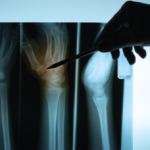NEW YORK (Reuters Health)—A “biomechanical” analysis of a previously taken pelvic or abdominal computed tomography (CT) scan is at least as accurate in assessing an individual’s hip fracture risk as a dual-energy X-ray absorptiometry (DXA) scan, according to new research.
This accuracy of the hip bone mineral density (BMD) T-score as measured by the biomechanical CT (BCT) analysis was consistent for all fracture-risk metrics and both sexes, researchers found in a retrospective case-cohort study of nearly 4,000 participants.
Further, combining the classifications of fragile femoral bone strength and hip osteoporosis from BCT data resulted in higher sensitivity than the standard hip/spine osteoporosis classification by DXA, with comparable specificity.
In people who are already having a CT done for some other reason, particularly those aged 65 or older, “we can now screen them for osteoporosis simultaneously, sparing them the need for a separate DXA scan,” lead author Dr. Annette Adams of Kaiser Permanente Southern California tells Reuters Health by email. “Additionally, by screening the CT scans, we may pick up some people with osteoporosis or fragile bone strength who wouldn’t otherwise be screened by DXA.”
“This is significant,” she adds, because if an individual is identified as having osteoporosis, they can receive care to reduce the risk of a fracture. Such care could include medication, taking calcium and vitamin D, regular exercise and avoiding excessive tobacco and alcohol.
“When you save an older person from a fracture, you just may be saving their life,” Dr. Adams says.
The findings were published online April 17 in the Journal of Bone and Mineral Research.1
The researchers used data on more than 111,000 Kaiser Permanente patients who were 65 or older and had had a DXA scan within three years of a CT scan and no hip fracture before either scan. From this population, they matched 1,959 patients who later experienced a first non-traumatic hip fracture with 1,979 who did not.
BCT analyses of all participants’ existing CT scans were performed at a single lab that was blinded as to hip fracture status, clinical factors and DXA date.
Patients who fractured a hip were older, had lower BMD and lower body mass index and included more whites and fewer Asians, blacks and Hispanics.
Combining the classifications of fragile femoral bone strength and hip osteoporosis from BCT data resulted in higher sensitivity for predicting hip fracture than the standard hip/spine osteoporosis classification by DXA (0.66 vs. 0.59 for women; 0.56 vs. 0.48 for men), with comparable specificity (0.66 vs. 0.67 and 0.76 vs. 0.78, respectively).
“By all metrics and for both sexes,” the researchers write, “the hip BMD T-score [lower of femoral neck and total hip values] for the BCT analysis performed at least as well as DXA testing for assessing risk of hip fracture.”
They note that BCT analysis of 86% of the available CT scans was successful and that the latter had been performed on 80 different CT scanners in 14 hospitals over a nine-year period, supporting “technical robustness in a broad clinical setting.”
The authors concluded that if BCT analysis were routinely used in individuals over age 65 “who have an available hip CT when a recommended DXA test is either missing, not available, or inconvenient … such a ‘second front’ in osteoporosis screening, could appreciably increase the number of patients identified as being at high risk of hip fracture.”
Dr. Timothy Ziemlewicz, a radiologist at the University of Wisconsin School of Medicine and Public Health, Madison, tells Reuters Health by email that osteoporosis screening rates are low, even in those eligible under U.S. Preventive Services Task Force guidelines.
“An add-on analysis of imaging data already available stands to improve these screening rates and also offer screening to patients who are not covered within guidelines, but nevertheless have potential fracture risk,” says Dr. Ziemlewicz, who was not involved in the study.
“Abdominopelvic CT is a common study, particularly in the Medicare population,” he added. “An opportunistic screen can allow detection and treatment of osteoporosis and therefore has the potential to decrease hip fractures.”
He did have a few caveats about this study, including the relatively long period—up to three years—between DXA and CT scans, over which there could be a significant change in BMD, and variations in beam energy in the CT scans.
“Overall, this study adds to the idea that CT examinations of the abdomen and pelvis performed for other indications provide a great opportunity to improve osteoporosis screening rates,” Dr. Ziemlewicz says.
Three of the authors of the new report have financial interests in O.N. Diagnostics, which performed the BCT analyses for the study and developed VirtuOst, the software used for those analyses.
The study was supported by Amgen and Merck, which make osteoporosis drugs.
Reference
- Adams AL, Fischer H, Kopperdahl DL, et al. Osteoporosis and hip fracture risk from routine computed tomography scans: The fracture, osteoporosis and CT utilization study (FOCUS). J Bone Miner Res. 2018 Apr 17. doi: 10.1002/jbmr.3423. [Epub ahead of print]

